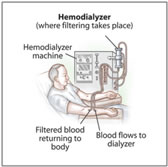Minnesota Vascular Surgery Center suggests the following sites as resources for patients as they continue to learn more about their own health and the treatment of vascular disease.
Educational Resources
- American Diabetes Association
- National Kidney Foundation
- American Association of Kidney Patients
- Vascular Web
- National Diabetes Education Program
- Kidney School
- Kidney Options
Patient Education
Questions and Answers about Hemodialysis
Your kidneys are organs in your body that remove extra chemicals, waste products and extra water. As blood passes through your kidneys, they recognize these extra things and remove them. You have been told by your kidney doctor that your kidneys are not working as well as they should. Now that your kidneys aren’t working as well as they should, you will need some type of therapy that will “replace” these important organs.
Q. What is hemodialysis?

A. Hemodialysis is a process that will remove extra chemicals, waste and water from your bloodstream or “replace” your kidneys. Hemodialysis uses an “artificial kidney” or “dialyzer”. As your blood passes through this dialyzer, the extra chemicals, waste and water will be removed. Your blood will be cleaned of these chemicals and wastes each time your blood passes through the dialyzer. In order to accomplish hemodialysis, you will need an “access” to your bloodstream.
The amount of waste products and excess chemicals that are removed during a hemodialysis treatment depends on how long you are treated and how fast the blood can move through the artificial kidney.
If you dialyze for three hours and the blood can run through the dialyzer at 400 milliliters per minute, you will have 72 liters of blood pass through the dialyzer. If you dialyze for three hours and the blood can run through the dialyzer at 500 milliliters per minute, you will have 90 liters of blood pass through the machine.
The more times your blood runs through the dialyzer, the more chemicals and waste will be removed, the better you will feel.
Q. What kinds of “accesses” are there?
A. There are three types of accesses:
- AV Fistula (preferred)
- PTFE (polytetrafluoroethylene) Graft
- Tunneled Catheter
Q. What are the differences between these accesses?
A. All three will give “access” to your bloodstream. The AV fistula is created out of your own natural blood vessels by connecting an artery to a vein. A PTFE Graft is a tube, made out of synthetic material that is surgically placed under your skin. One end of this PTFE graft is attached to an artery and the other end would be attached to a vein. A tunneled catheter is a plastic tube that is inserted under your skin and “tunneled” into a vein.
Q. How do I choose which access is right for me?
A. The decision about which access is right for you must be made between you, your kidney doctor and the doctor who creates your access. The three different accesses are available because there isn’t any one choice that will work for everyone. There are many factors to consider when choosing an access.
The amount of waste products and excess chemicals that are removed during hemodialysis treatments depend on how long you are treated and how fast the blood can move through the artificial kidney, the more times your blood runs through the dialyzer, the more chemicals and waste will be removed, the better you will feel.
Q. Why is the AV Fistula the preferred access?
A. AV Fistulas are created out of your own blood vessels, and typically AV Fistulas have excellent blood flow and studies have shown that they provide the best blood flow with the least complications.
